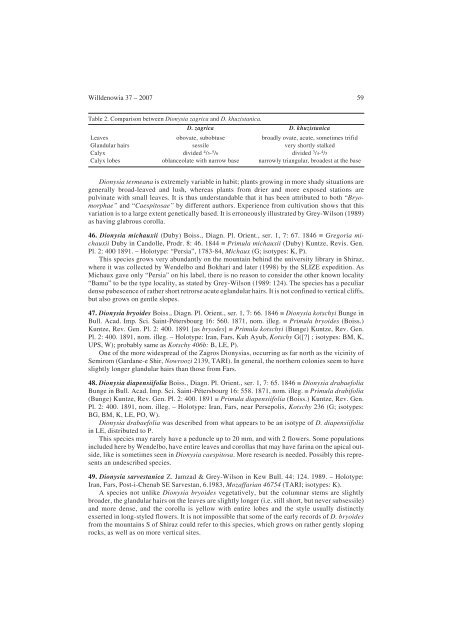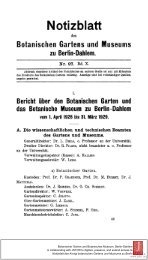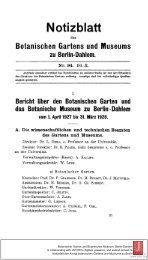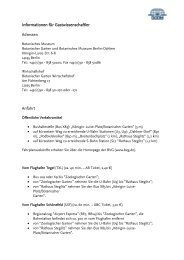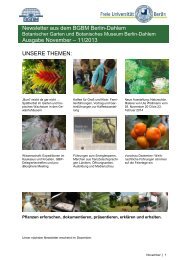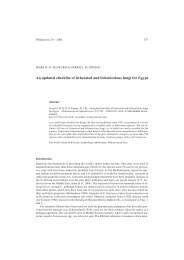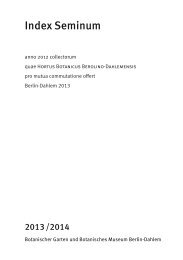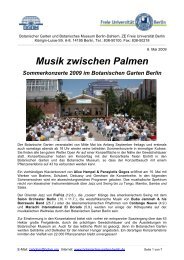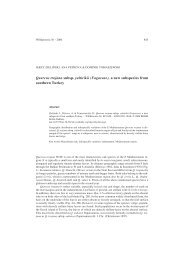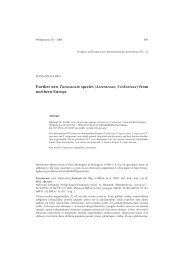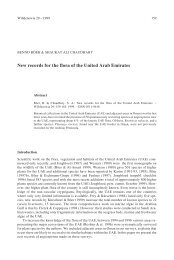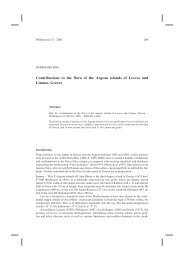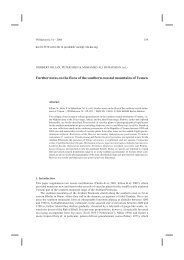The genus Dionysia (Primulaceae), a synopsis and five new species
The genus Dionysia (Primulaceae), a synopsis and five new species
The genus Dionysia (Primulaceae), a synopsis and five new species
You also want an ePaper? Increase the reach of your titles
YUMPU automatically turns print PDFs into web optimized ePapers that Google loves.
Willdenowia 37 – 2007 59<br />
Table 2. Comparison between <strong>Dionysia</strong> zagrica <strong>and</strong> D. khuzistanica.<br />
D. zagrica D. khuzistanica<br />
Leaves obovate, subobtuse broadly ovate, acute, sometimes trifid<br />
Gl<strong>and</strong>ular hairs sessile very shortly stalked<br />
Calyx divided 4 /5-5 /6 divided 3 /4-4 /5<br />
Calyx lobes oblanceolate with narrow base narrowly triangular, broadest at the base<br />
<strong>Dionysia</strong> termeana is extremely variable in habit; plants growing in more shady situations are<br />
generally broad-leaved <strong>and</strong> lush, whereas plants from drier <strong>and</strong> more exposed stations are<br />
pulvinate with small leaves. It is thus underst<strong>and</strong>able that it has been attributed to both “Bryomorphae”<br />
<strong>and</strong> “Caespitosae” by different authors. Experience from cultivation shows that this<br />
variation is to a large extent genetically based. It is erroneously illustrated by Grey-Wilson (1989)<br />
as having glabrous corolla.<br />
46. <strong>Dionysia</strong> michauxii (Duby) Boiss., Diagn. Pl. Orient., ser. 1, 7: 67. 1846 ≡ Gregoria michauxii<br />
Duby in C<strong>and</strong>olle, Prodr. 8: 46. 1844 ≡ Primula michauxii (Duby) Kuntze, Revis. Gen.<br />
Pl. 2: 400 1891. – Holotype: “Persia”, 1783-84, Michaux (G; isotypes: K, P).<br />
This <strong>species</strong> grows very abundantly on the mountain behind the university library in Shiraz,<br />
where it was collected by Wendelbo <strong>and</strong> Bokhari <strong>and</strong> later (1998) by the SLIZE expedition. As<br />
Michaux gave only “Persia” on his label, there is no reason to consider the other known locality<br />
“Bamu” to be the type locality, as stated by Grey-Wilson (1989: 124). <strong>The</strong> <strong>species</strong> has a peculiar<br />
dense pubescence of rather short retrorse acute egl<strong>and</strong>ular hairs. It is not confined to vertical cliffs,<br />
but also grows on gentle slopes.<br />
47. <strong>Dionysia</strong> bryoides Boiss., Diagn. Pl. Orient., ser. 1, 7: 66. 1846 ≡ <strong>Dionysia</strong> kotschyi Bunge in<br />
Bull. Acad. Imp. Sci. Saint-Pétersbourg 16: 560. 1871, nom. illeg. ≡ Primula bryoides (Boiss.)<br />
Kuntze, Rev. Gen. Pl. 2: 400. 1891 [as bryodes] ≡ Primula kotschyi (Bunge) Kuntze, Rev. Gen.<br />
Pl. 2: 400. 1891, nom. illeg. – Holotype: Iran, Fars, Kuh Ayub, Kotschy G([?] ; isotypes: BM, K,<br />
UPS, W); probably same as Kotschy 406b: B, LE, P).<br />
One of the more widespread of the Zagros <strong>Dionysia</strong>s, occurring as far north as the vicinity of<br />
Semirom (Gardane-e Shir, Nowroozi 2139, TARI). In general, the northern colonies seem to have<br />
slightly longer gl<strong>and</strong>ular hairs than those from Fars.<br />
48. <strong>Dionysia</strong> diapensiifolia Boiss., Diagn. Pl. Orient., ser. 1, 7: 65. 1846 ≡ <strong>Dionysia</strong> drabaefolia<br />
Bunge in Bull. Acad. Imp. Sci. Saint-Pétersbourg 16: 558. 1871, nom. illeg. ≡ Primula drabifolia<br />
(Bunge) Kuntze, Rev. Gen. Pl. 2: 400. 1891 ≡ Primula diapensiifolia (Boiss.) Kuntze, Rev. Gen.<br />
Pl. 2: 400. 1891, nom. illeg. – Holotype: Iran, Fars, near Persepolis, Kotschy 236 (G; isotypes:<br />
BG,BM,K,LE,PO,W).<br />
<strong>Dionysia</strong> drabaefolia was described from what appears to be an isotype of D. diapensiifolia<br />
in LE, distributed to P.<br />
This <strong>species</strong> may rarely have a peduncle up to 20 mm, <strong>and</strong> with 2 flowers. Some populations<br />
included here by Wendelbo, have entire leaves <strong>and</strong> corollas that may have farina on the apical outside,<br />
like is sometimes seen in <strong>Dionysia</strong> caespitosa. More research is needed. Possibly this represents<br />
an undescribed <strong>species</strong>.<br />
49. <strong>Dionysia</strong> sarvestanica Z. Jamzad & Grey-Wilson in Kew Bull. 44: 124. 1989. – Holotype:<br />
Iran, Fars, Post-i-Chenab SE Sarvestan, 6.1983, Mozaffarian 46754 (TARI; isotypes: K).<br />
A <strong>species</strong> not unlike <strong>Dionysia</strong> bryoides vegetatively, but the columnar stems are slightly<br />
broader, the gl<strong>and</strong>ular hairs on the leaves are slightly longer (i.e. still short, but never subsessile)<br />
<strong>and</strong> more dense, <strong>and</strong> the corolla is yellow with entire lobes <strong>and</strong> the style usually distinctly<br />
exserted in long-styled flowers. It is not impossible that some of the early records of D. bryoides<br />
from the mountains S of Shiraz could refer to this <strong>species</strong>, which grows on rather gently sloping<br />
rocks, as well as on more vertical sites.


